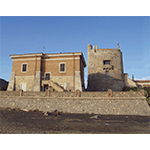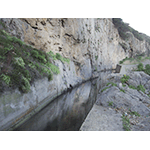"Tagliata" of Ansedonia
At the foot of the hill occupied by the Roman colony of Cosa (273 B.C.), a port was built and equipped with impressive infrastructures, in part still visible. To prevent the port from silting up and to guarantee a constant exchange of water, a large fissure of the promontory of Ansedonia, the so-called "Spacco della Regina" (queen’s cleft), was equipped with mobile bulkheads, the recesses of which are still visible in the rock. The wooden doors were opened according to the season, in order to let water in or out of the dock and thus avoid it from stagnating and debris from accumulating.
A new draining system was realised in the 2nd century B.C. to replace the previous one. This expedient, known as "Tagliata" (cut) consists of an artificial canal dug into the rock, partially in tunnels and partially open-air, for a length of more than 80 metres. The interior of the Tagliata can be visited today, crossing over a little bridge over the modern canal.
****************************
Texts by Elena Fani
English translation by Victor Beard
Last update 22/gen/2008





